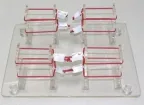The reasons for introducing the superficial knotting skill training model in medical education are mainly based on the following points:
First of all, superficial knotting is a basic skill in surgery, and it is essential for medical students to master this skill. The traditional way of medical education often focuses on theoretical teaching, but lacks the opportunity of practical operation. However, the knotting technique takes a lot of practice to truly master. Therefore, the introduction of superficial knotting skills training model provides a practical platform for medical students to simulate the real surgical environment, so that they can practice repeatedly in a safe and controllable environment, so as to improve their knotting skills.

Secondly, it has a high degree of simulation and practicality. These models are often made of high-quality materials and are able to simulate real surgical scenarios and operating conditions. Through practice, medical students can gradually get familiar with and master the basic knot-tying techniques and skills, and understand the problems that may be encountered in practical operation and coping strategies. This simulation training helps to shorten the transition time from theory to practice for medical students and improve their performance in actual surgery.
In addition, the introduction of the superficial knotting skill training model is also helpful to cultivate the teamwork and communication ability of medical students. During the simulated operation, medical students need to cooperate with their partners to complete the task together. This exercise not only tested their operational skills, but also exercised their teamwork and communication skills, laying the foundation for future practical work.
Finally, with the continuous progress of medical technology and the continuous innovation of surgical methods, the skill requirements for medical students are also constantly increasing. The introduction of superficial knotting skills training model can help medical students keep up with The Times, master the latest surgical techniques and methods, and make contributions to the future medical career.
To sum up, the introduction of superficial knotting skills training model in medical education is to improve the knotting skills of medical students, cultivate the ability of teamwork and communication, and adapt to the progress of medical technology.
